-
Membership
Membership
Anyone with an interest in the history of the built environment is welcome to join the Society of Architectural Historians -
Conferences
Conferences
SAH Annual International Conferences bring members together for scholarly exchange and networking -
Publications
Publications
Through print and digital publications, SAH documents the history of the built environment and disseminates scholarshipLatest Issue:

-
Programs
Programs
SAH promotes meaningful engagement with the history of the built environment through its programsMember Programs
-
Jobs & Opportunities
Jobs & Opportunities
SAH provides resources, fellowships, and grants to help further your career and professional life -
Support
Support
We invite you to support the educational mission of SAH by making a gift, becoming a member, or volunteering -
About
About
SAH promotes the study, interpretation, and conservation of the built environment worldwide for the benefit of all
Naples and Campania, Day Four, 16 May 2008
by: Mia Reinoso Genoni
miagenoni@post.harvard.edu

Our focus on Campanian Antiquity ended with a series of visits to sites of the “Phlegrean Fields” (Campi Flegrei); derived from the Greek phlegraios, or “burning,” this area is west of Vesuvius and includes Naples, Baia, and Cumae. We started at Baia, which was a popular Roman resort and spa, featuring numerous volcanic hot springs. It was not harmed by Vesuvius, and was a site of interest for the ruling families of Naples throughout her long history. Pictured here is an image of the Aragonese fortress in Baia, taken from offshore during our boat trip.
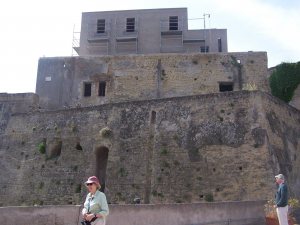
Baia was named after Baios, Odysseus’ navigator, believed to have died in the bay. The fortress now houses the Archaeological Museum of the Phlegrean Fields.
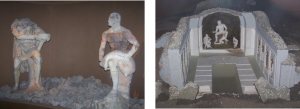
In the museum are the remnants of the Nymphaeum at Punta Epitaffio (left) as well as a model reconstruction (right). The Nymphaeum was a luxury banquet hall, and the scene featured Odysseus and Baios serving Polyphemus.

Our next stop was to the aptly named Piscina Mirabile, easily one of the most memorable and awe-inspiring structures I have ever encountered. So-named by Petrarch, it is a Roman reservoir that collected rainwater for the fleet at Misenium, dating to the Age of Augustus. The structure is 15 m deep, 70 m long, and 25.5 m wide, dug into the tufa and covered in cocciopesto to waterproof the walls. As this picture shows, many of us were simply awestruck by the Piscina…
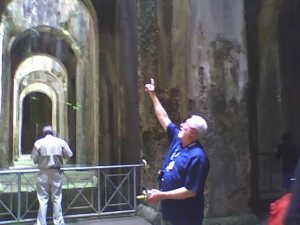
though John Martine, who kindly agreed to serve as my referent for scale (5’7″ – see below), expressed the sentiment best.
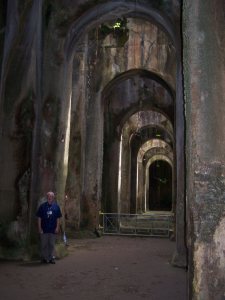
Even these pictures, which cannot do justice to the magnificent structure, continue to amaze me. I find myself continually reminded of the Cathedral of Speyer in Germany. For more details on the Piscina, there is an English-language tourism information site that is helpful: http://www.ulixes.it/english/e_pg02afr06a.html
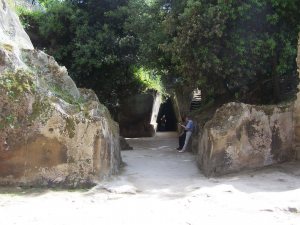
Still agog, we turned our attention to Cumae, which was the earliest Greek colony on the Italian peninsula, dating to c. 740 BCE. Seen here is the entrance to the Sybil’s Grotto. As Virgil reports in the Aeneid, the Cumaean Sibyl was greatly venerated during the Age of Augustus. The Grotto is an intensely yonic structure, with a ponderous triangular entrance at which one was supposed to whisper questions, and receive the answer without ever catching a glimpse of the Sybil.
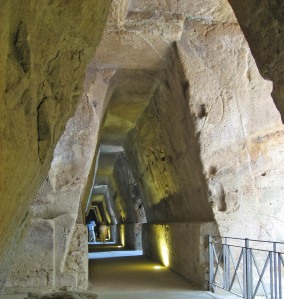
This interior view accurately conveys the heft and power of the structure.
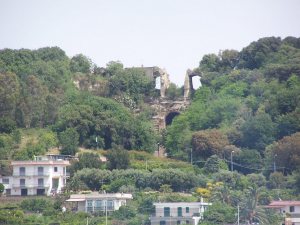
A medieval fortress was built among the ancient ruins, and from it one can see the Arco Felice in the distance, evidence of the Roman infrastructure.
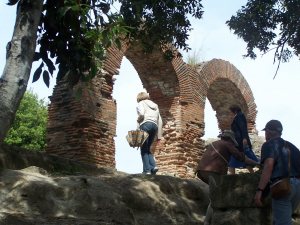
After climbing all the way up the via Sacra one reaches the so-called Temple of Jupiter, where one can see both the (reinforced) remnants of Antiquity…
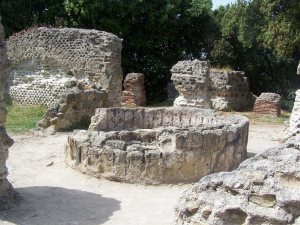
as well as Early Christian adaptations, such as the baptistery basin.
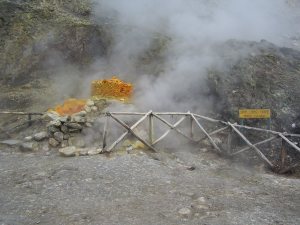
We ended our visit to the Phlegrean Fields with a trip to the Cratere della Solfatara, one of the youngest and best preserved volcanoes in the area. Also on site are a Roman sudatorium and a Bourbon Vulcanologic Observatory, further reminders of the many and layered histories of Campania.
miagenoni@post.harvard.edu

Our focus on Campanian Antiquity ended with a series of visits to sites of the “Phlegrean Fields” (Campi Flegrei); derived from the Greek phlegraios, or “burning,” this area is west of Vesuvius and includes Naples, Baia, and Cumae. We started at Baia, which was a popular Roman resort and spa, featuring numerous volcanic hot springs. It was not harmed by Vesuvius, and was a site of interest for the ruling families of Naples throughout her long history. Pictured here is an image of the Aragonese fortress in Baia, taken from offshore during our boat trip.

Baia was named after Baios, Odysseus’ navigator, believed to have died in the bay. The fortress now houses the Archaeological Museum of the Phlegrean Fields.

In the museum are the remnants of the Nymphaeum at Punta Epitaffio (left) as well as a model reconstruction (right). The Nymphaeum was a luxury banquet hall, and the scene featured Odysseus and Baios serving Polyphemus.

Our next stop was to the aptly named Piscina Mirabile, easily one of the most memorable and awe-inspiring structures I have ever encountered. So-named by Petrarch, it is a Roman reservoir that collected rainwater for the fleet at Misenium, dating to the Age of Augustus. The structure is 15 m deep, 70 m long, and 25.5 m wide, dug into the tufa and covered in cocciopesto to waterproof the walls. As this picture shows, many of us were simply awestruck by the Piscina…

though John Martine, who kindly agreed to serve as my referent for scale (5’7″ – see below), expressed the sentiment best.

Even these pictures, which cannot do justice to the magnificent structure, continue to amaze me. I find myself continually reminded of the Cathedral of Speyer in Germany. For more details on the Piscina, there is an English-language tourism information site that is helpful: http://www.ulixes.it/english/e_pg02afr06a.html

Still agog, we turned our attention to Cumae, which was the earliest Greek colony on the Italian peninsula, dating to c. 740 BCE. Seen here is the entrance to the Sybil’s Grotto. As Virgil reports in the Aeneid, the Cumaean Sibyl was greatly venerated during the Age of Augustus. The Grotto is an intensely yonic structure, with a ponderous triangular entrance at which one was supposed to whisper questions, and receive the answer without ever catching a glimpse of the Sybil.

This interior view accurately conveys the heft and power of the structure.

A medieval fortress was built among the ancient ruins, and from it one can see the Arco Felice in the distance, evidence of the Roman infrastructure.

After climbing all the way up the via Sacra one reaches the so-called Temple of Jupiter, where one can see both the (reinforced) remnants of Antiquity…

as well as Early Christian adaptations, such as the baptistery basin.

We ended our visit to the Phlegrean Fields with a trip to the Cratere della Solfatara, one of the youngest and best preserved volcanoes in the area. Also on site are a Roman sudatorium and a Bourbon Vulcanologic Observatory, further reminders of the many and layered histories of Campania.


Leave a commentOrder by
Newest on top Oldest on top